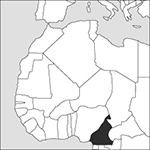
Capital:
Yaoundé
Area:
475,440 sq km (183,568 sq miles)
Population:
20,549,221 (2012 est)
Currency:
1 CFA franc = 100 centimes
Religions:
traditional religions 40.0%; Christian 40.0%; Muslim 20.0%
Ethnic Groups:
Cameroon Highlanders 31.0%; Equatorial Bantu 19.0%; Kirdi 11.0%; Fulani 10.0%; Northwestern Bantu 8.0%; Eastern Nigritic 7.0%
Languages:
French, English (both official); over two hundred African languages and dialects
International Organizations:
UN; AU; Commonwealth; Non-Aligned Movement; Franc Zone; WTO
A country in West Africa, with Nigeria and Chad to its west and north, the Central African Republic to its east, and Gabon and Congo to the south.
Physical
Most of the coastline is low, with creeks, lagoons, and swamps, although near Mount Cameroon, an active volcano, there are steep cliffs. The coastal plain is hot and very wet and covered with thick rainforest. Inland the ground rises to the plateau that makes up most of the country.
Economy
Crude oil and oil products are the largest exports, and their revenue has assisted agricultural and industrial development, but the reserves are becoming depleted and production is half of its peak in the 1980s. Other industries include aluminium smelting (from imported bauxite and alumina), food processing, and consumer goods. Apart from oil, mineral deposits include natural gas, gold, uranium, bauxite, nickel, and cobalt. Over two-thirds of the population are engaged in agriculture, with coffee, cocoa, and cotton being exported.
History
The Portuguese and other Europeans who explored Cameroon in the 15th and 16th centuries found that it was mainly uninhabited, but it was believed to be the original home of the Bantu peoples. About 1810 King Mbwé-Mbwé walled his capital, Fomban, against the Fulani empire of Sokoto. Other peoples set up small kingdoms. Germans began trading c.1860, and signed protectorate treaties in 1884. The German Protectorate of Kamerun was confirmed by the Franco-German Treaty of 1911, but in 1916 Anglo-French forces occupied it. From 1919 it was administered under League of Nations (later UN) trusteeship, having been divided into British and French mandates. In 1960 the French Cameroons became an independent republic, to be joined in 1961 by part of the British Cameroons, the remainder becoming part of Nigeria. The French and British territories in 1972 merged as the United Republic of Cameroon, later renamed the Republic of Cameroon. It was from 1972 a one-party republic ruled by the Cameroon People’s Democratic Movement, from 1982 under President Paul Biya. Legislation providing for multiparty government was adopted in 1990 and, following strikes, demonstrations, and unrest through 1991, President Biya finally held elections in 1992. Biya was re-elected in presidential elections (also held in 1992) but the result was rejected by opponents, who alleged that fraud had taken place. He was again re-elected in 1997—when the opposition boycotted the poll—2004, and 2011. Cameroon joined the Commonwealth of Nations in 1995. In 2006, Nigeria accepted an International Court ruling that the Bakassi peninsula, which is rich in mineral resources, was part of Cameroon, who finally took over full control in 2013. Since 2014, there have been a number of Boko Haram attacks in northern Cameroon, close to the Nigerian border. It has also received over 300,000 refugees who have fled from conflicts in Nigeria and the Central African Republic.
- magnetic drum
- magnetic elements
- magnetic encoding
- magnetic equator
- magnetic fabric determination
- magnetic field
- magnetic field strength
- magnetic field strength(symbol: H; unit: ampere/metre)
- magnetic flux
- magnetic flux density
- magnetic flux density(symbol: B; unit: tesla (weber/metre2))
- magnetic flux(symbol: Φ; unit: weber)
- magnetic focusing
- magnetic force
- magnetic gradiometry
- magnetic head
- magnetic hysteresis
- magnetic induction
- magnetic-ink character recognition
- magnetic intensity
- magnetic inversion line
- magnetic leakage
- magnetic lens
- magnetic loudspeaker
- magnetic media